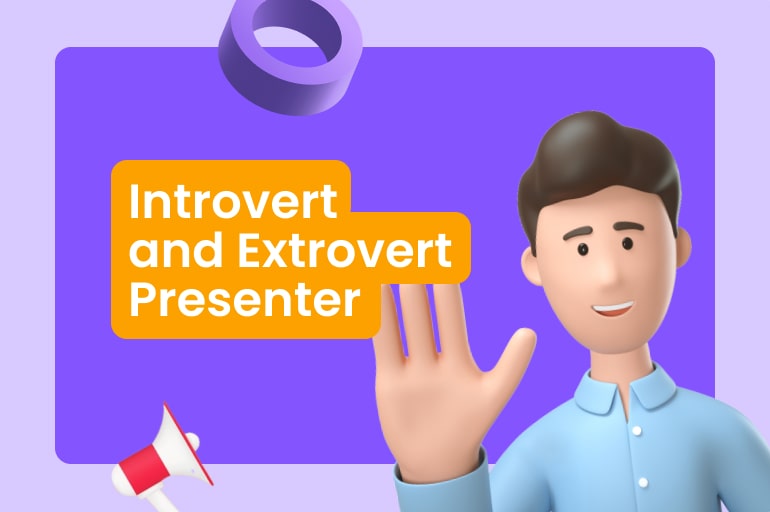Introvert vs. Extrovert presenters is more than “shy” and “sociable” – here’s why understanding this part of your personality matters.
First, why do we talk about Introvert vs. Extrovert Presenters here? Does your personality directly affect your performance in a presentation?
It involves two ways: how you tell your audience and how they receive it. There are both suitable and not-so-good sides to each personality.
That’s what you will learn here to improve your presentation skill based on your personality. Introvert or extrovert? Which one are you, and how will you improve? Let’s start!
What’s the difference between an Introvert vs. Extrovert person?
Introvert and extrovert words are only about how people relate to themselves and their world.
The biggest difference between the Introvert vs. Extrovert Presenters is how each prefers to spend their time.
According to Very Well Mind, people tend to be more extroverted or introverted for two main reasons: nature and nurture.
Genetics: There is a vital genetic component to extroversion. Genetics accounts for 40% to 60% of the variance between extroversion and introversion in twin studies
Environment: Sibling research published in 2011 suggests that individual experiences weigh more than shared experiences among family members
A person may be an introvert if:
- They feel enjoy spending time alone.
- They prefer quality time with one or two people rather than spending time with bigger groups.
- They need time to rest and recharge their energy after a busy workday or period of activity.
- They can easily get lost in their thoughts and need time to process and think through most things.
A person may be an extrovert if:
- They prefer spending time around other people and dislike being alone sometimes.
- They like crowds, parties, and gatherings with many new people.
- They recharge their energy by spending time with others.
- They are outgoing, talkative, and like being the center of attention.
We can also consider how we feel after socializing to know if we’re more introverted or extroverted.
We often see that extroverts feel recharged around a crowd and connect with more people, while introverts may feel tired by that experience.
How does an introvert and extroverts person differ in presentation style?
Every presenter has a combination of introverts and extroverts, which means they like to think and process everything they say.
They want to interact and engage with everything they say.
For the content pieces of a presentation, the difference between the two presenters’ segments is somewhat insignificant.
The information from them will be the same for the most part.
However, if we examine them too deeply into the details, we may find extroverts will take over the stage and audiences.
If we skip the details entirely, we will find that introverts will mentally remove all reliability and excellence as a presenter.
But suppose we keep things within a usual place of explanation, storytelling, and tempo. In that case, both of those personalities will probably track just fine.
We will get the more significant proof by dividing from this personality gap when their presentation becomes interactive or requires feedback or involvement from the audience.
Once again, the primary manner of an extrovert is personal energy. Introverts tend to get more mental or physical energy from the “playground of their mind.”
It doesn’t mean that an introvert is shy or anti-social and is anything but self-centered. Extroverts are stimulated by everything around them.
So, being in front of an audience likely starts them with a natural charge. On the other side, introverts have to manage their energy through the process of introspection from the inside out.
Here, we break down into two in-depth explanations of the difference between an Introvert vs. Extrovert Presenter.
Introvert Presenter: The super detail
According to Fabricio Teixeira, introverts usually compensate for their discomfort with verbal communication through more polished, detailed, and specific design deliverables.
They typically cover all imaginable use cases and variations: straightforward user journeys, impeccable wireframes, and sitemaps.
In short, they included all details and covered all technical explanations.

Good point:
Here are the three top strengths that introverts bring to a presentation:
- Having so many details covered, there will be no more technical questions.
- Tend to have an inherent quality of being good preparation.
- Have more opportunities to listen and self-disclose later.
- They are not people who usually like to chitchat. They focus on getting to the heart of the conversation.
Introverts tend to think before talking. When they have their opinion, they don’t say anything.
Not, at least, until they’ve had time to think it over.
Weakness:
We are only human, and so the presenter is. As an introverted presenter, the weakness that they may tend to get is:
Slides tend to be heavier on content (many slides), making each person in the room focus on a different part of what’s shown.
This will lead a person to question already explained things–not a good thing for our fellow introverts.
Tips for Introverts:
Still nervous about presenting in front of an audience? Consider following these tips:
Audience first
Our audience’s needs are vital for introverts and extroverts, but focus on what can help ease the pressure off ourselves.
Try addressing them conversationally, asking rhetorical questions that meet their needs, and making them focused.
Keep this in mind as we develop content and practice our speech, as it can help ease some of the worries about being the center of attention.
Fake it
Start with a bold, extrovert smile and positive affirmation to build our spiritual courage.
Plenty of singers, comedians, and actors have been introverts: the secret is that their on-stage appearance becomes another identity they wear like masks.
Get the audience on your side
As an internal processor, introverts can feel disconnected from crowds.
Forming a connection with them can help us feel more comfortable during the rest of our speech.
They quietly think through various problems, solutions, and scenarios when they step on stage by warming up to our audience.
Start with a joke, a story, or something that excites a physical response from the audience.
If we’re introverts, we may be uncomfortable or completely terrified about public speaking.
And while those fears are pretty natural, being an introvert can benefit from becoming a master presenter.
See also: How to Prepare for a Speech in One Day When Having Presentation Fear
Extrovert Presenter: A storyteller
Extroverts with more vital verbal communication skills can capture people’s attention.
Their slides tend to be sharper, more focused, and work more to remind the designer of the chapters of the story they are trying to tell.
They make the audience focus on the story being told in the meeting.

Good point:
Here are three advantages if you are an extrovert when performing yourself in front of an audience:
- Extrovert storytellers know how to cultivate the story to ensure audiences in the room can relate to both problems and solutions.
- They have social confidence and love talking.
- They can get their message across and be influential or persuasive.
Extroverts tend to think out loud. It’s not because they think before speaking. They speak while they are feeling.
We hear it isn’t necessarily their final thought on the matter; it’s their thought process.
Let’s ask extroverts to express their opinion, and they will likely open their lips and begin speaking.
Weakness:
There will be a lousy point instead of a good point, so the weakness that we may tend to get as an extrovert presenter, we will:
Focus on the ‘humanize the story’ making the extroverts not highlight the facts and the technical.
It will leave the audience vague understanding of how certain functionality will work.
Tips for Extroverts:
Worry not; we have three tips to avoid some presentation mistakes as an extrovert presenter.
Ask and engage
Please focus on the audience instead of the performance by asking your listeners’ answers and giving them time to talk about what’s important.
We won’t be shy about asking, and any extroverted audience will be happy to pitch in to create a conversation rather than merely a monologue.
If we don’t want to include a question and answer session in our speech, ask rhetorical questions, encourage them to think about them, and speak with us after the session.
Utilize pauses
We may find that the energy we get from others can affect us to become a little too excited, jumping from topic to topic or speeding up our pace.
Plan pauses during our presentation to slow our pacing, or even consider practicing with a metronome to help stop plenty of word overflow.
Practice a million times
We may be comfortable jumping into a situation like a speech or presentation without planning since we get a rush from taking risks.
Don’t make that fatal mistake! Please put on the mask of our introverted match and internally prepare for our time on stage.
Whether we are introverts, extroverts, or a little bit of both, start by uncovering where we come upon the spectrum to fully prepare for the following speech.
Who knows? Working through some of our weaknesses may get us to enjoy public speaking.
See also: Question and Answer Session: The Most Important Elements of a Presentation
Who’s the Better Presenter, an Extrovert or an Introvert?
We know that Introvert vs. Extrovert presenters is complex. We believe we’re born one way or another, and we don’t change much during our lifetimes.
But, we also know from experience that being a speech mentor or an audience or an Introvert vs. Extrovert presenter will make no difference in being a good presenter.
Here are the three reasons:
Being an extrovert or an introvert will not define the skills we develop or our actions
With the proper training, experience, and support, we can learn how to give powerful presentations, whether we’re introverts or extroverts.
Extroverts are more willing to stand up and give a speech, but that doesn’t necessarily make them better speakers.
On the contrary, it will run them to be disorganized people.
Whether we are extroverts or introverts, mastering the art, public speaking skill, experience, and taking the time to prepare and practice is the best way to become successful presenters.
Introvert vs. Extrovert presenters brings different sensibilities to make a presentation. And, different doesn’t mean bad; it just means different
There’s no fundamental style of presenting.
Also, not every style appeals to every audience. Sure, It helps a lot to choose the type of audience we address.
The trick is to put our values, outlook, knowledge, and (absolutely) sensibilities on the line when we speak.
Both extroverts and introverts use different resources and face other challenges as presenters
Extroverts tend to enjoy interacting with large groups.
And they tend to think on their feet, which makes it easier for them to deal with Q&A.
Besides, they sometimes need to give more attention to what they say.
Introverts tend to focus more on individuals, which can help them establish harmony with the audience (Charismatic speakers — Introvert vs. Extrovert presenters— know how to speak to each audience simultaneously).
To know precisely what they will say before being called upon, they must prepare for the questions they might get.
See also: Using Speaker Notes in PowerPoint to Create Winning Presentation
How to Create Balancing Interactivity in a Presentation between Two Personas?
We can’t force a person to be someone they’re not. You are forcing introverts to be more talkative or the opposite.
A more realistic scenario is; to know yourself and find what you are capable of, then compare yourself to what others can.
This is like learning your best points, then trying to improve anything you lack.
First, as I said before, know yourself. Are you introverted or extroverted?
If you’re working in a team, ask your manager to pair you with a talkative friend (or if you’re a manager, you can arrange and balance your team!).
Try to balance your team to have professionals that sit in different places of the introvert-extrovert spectrum. It is not easy, I know.
People with different personalities tend to have different opinions.
But these differences, in the end, will improve each other skills.
Swallow your ego, and take any advice and critics as your point of improvement.
Introvert vs. Extrovert Presenters: How not to be stuck in the middle?
Everyone has the same chance to be a speaker, whatever personality you have.
Do you know what’s essential besides your skill and presentation content?
It’s the way you design your slides. Trust me, visuals are crucial.
According to Splento, not only is visual content attention-grabbing, but it is a powerful tool for helping your audience to understand your content.
The majority of us are visual learners.
According to Forbes, 65% of us are visual learners. Visuals are much more likely to effectively communicate your message, given that 90% of information transmitted to the brain is visual.
Here’s the advice from Fabricio Teixeira:
Create two versions of your document
Two versions of the pitch are available: the pitch and the documentation.
The story can be divided into two parts, one focusing on the emotional side and the other on the details.
Bring prototypes instead of static boards
Bring videos instead of photos, and bring mockups instead of grayscale wireframes.
Make the work shine. Polish can help reduce cognitive friction for the people in the room.
Avoid a defensive tone when answering questions from your peers in the room
You left a few holes when explaining your document if they have questions.
Be respectful, listen to the question carefully, confirm what the question is before answering, and be soft on your tone.
99% of the questions are focused on making the work stronger.
Put yourself in the user’s shoes when telling a story
Instead of “this is how I imagine the homepage will work,” focus more on “this is what our persona John will see when he lands on the homepage.”
This little trick helps others put themselves into the user’s shoes when judging the work — and keeping the user’s interests in mind when providing feedback on the design.
Tell the story in small beats
Others in the room are looking at and thinking about that problem for the very first time, while you have spent days or even weeks thinking about it.
You should be fair to them.
Don’t dive right in
Use the first 3 minutes of a meeting to recap the context, explain what you have been working on since the last time you met, and how you ended up with the result you are trying to show.
Remember that regardless of personality preference, almost everyone has presentation fear. Do more practice!
Conclusions
Find your fear. Name it.
Then talk to yourself in the second or third person before getting on the platform.
Sometimes, the slightest shifts can help relieve the social stress of giving a presentation.
Simply because other people are more energized, it means that extroverts are not always to become better presenters than introverts.
Being true to their color is the key to delivering a winning presentation for both Introvert vs. Extrovert presenters.
Let’s visit RRSlide to download free PowerPoint templates. But wait, don’t go anywhere and stay here with our Blog to keep up-to-date on all the best pitch deck template collections and design advice from our PowerPoint experts!





